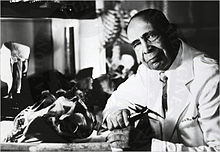- William Montague Cobb
-
Dr. William Montague Cobb was a pioneering 20th-century physical anthropologist. As the first African American to earn a Ph.D in anthropology, and the only one until after the Korean War,[1] his main focus in the anthropological discipline was studying the concept of race and the negative impact it has on communities of color.
Contents
Early life
Cobb was born on October 12, 1904 in Washington DC. His mother, Alexizne Montague Cobb grew up in Massachusetts and is partly of Native American descent. His father, William Elmer Cobb grew up in Selma, Alabama. They met in Washington DC when W. Montague’s father started his own printing business for the Black community.
The tipping point for Cobb’s initial interest in Anthropology came from a book of the animal kingdom that his grandfather owned. In this book, there were illustrations of human beings separated by race, but were illustrated with what Cobb called “equal dignity.” This instigated a pondering on the concept of race, as the same type of “equal dignity” was not granted in the society that surrounded Cobb’s life.
Education
Cobb graduated from Dunbar High School, which was considered to be of the best of African American high schools and continued on to earn his Bachelor of Arts from Amherst College in 1925. He continued his research in embryology at Woods Hole Marine Biology Laboratory, where he earned the Blodgett Scholarship for proficiency in Biology. He would later earn his MD (Doctor of Medicine) from the Howard University Medical School in 1929. Numan PG Adams, who was the Dean of Howard University at the time, was assigned the task of organizing a new faculty of African American physicians to help advance the school in the medical field. Cobb, in turn had the aspirations of creating a laboratory of anatomy and physical anthropology at Howard University that would have the resources for African American scholars to contribute instead of just defend debates in racial biology. He would then spend a few years at Case Western Reserve University[1], studying under T. Wingate Todd, where he would contribute to the Hamann-Todd Skeletal Collection, and eventually earn his Ph. D in Anthropology.
Legacy
Cobb distinguished himself by representing the pursuit of social responsibility in the field of anthropology, as well as by being a scholarly activist. In his studies and publications, he pursued disproving and dissolving misinformation including racially and socially biased studies in the fields of anatomy and anthropology. He believed that scholars of the academy must take responsibility “not only for their own thoughts and actions but also for their own society” because he believed that the values that are expressed, whether subtly or overtly, through studies, are key in the shaping of culture and society. He aspired to be the first anthropologist to undertake a demographic analysis that would expose the toll racism was taking on the African American population, and he wanted to create the resources so he would not be the last. His work illustrated the consequences of the human condition as a result of segregation and racism on both sides of the spectrum, and used his work to confront these issues. He also was the President of the NAACP from 1976 to 1982. He died November 20, 1990.
Publications
A few of Cobb's most celebrated works were the following:
- “Human Archives” – 1932
- “The Cranio-Facial Union and the Maxillary Tuber in Mammals” – 1943
- “Cranio Facial Union of Man” –1940
In addition the above three, Cobb had over 1100 publications on various topics
Finally, the article “Race and Runners,” published in 1936 focused on the runner Jesse Owens to dispel the idea that he was a quadruple gold medal winner based on his “ African American genes” and that accounted for decreased intelligence. Through numerous measures and physical tests Cobb found no distinct evidence that would place the physical attributes on race.
Footnotes
References
- Harrison, Ira E., and Faye V. Harrison, eds. African-American Pioneers in Anthropology. New York: University of Illinois P, 1998.
National Association for the Advancement of Colored People Leaders Presidents/CEOs
(executive secretaries 1910–77;
executive directors 1977–96)Frances Blascoer (1910–11) · Mary White Ovington (1911–12) · Mary Childs Nerney (1912–16) · Mary White Ovington (1916) · Royall Freeman Nash (1916–17) · James Weldon Johnson (1917–18) · John R. Shillady (1918–20) · James Weldon Johnson (1920–31) · Walter Francis White (1931–55) · Roy Wilkins (1955–77) · Benjamin Hooks (1977–92) · Benjamin Chavis Muhammad (1993–94) · Earl Shinhoster (1994–96) · Kweisi Mfume (1996–2004) · Dennis Courtland Hayes (2005) · Bruce S. Gordon (2005–7) · Dennis Courtland Hayes (2007–8) · Benjamin Jealous (2007–present)
Elected presidents
(1909–96, abolished)Moorfield Storey (1909–29) · Joel Elias Spingarn (1930–39) · Arthur B. Spingarn (1940–65) · Kivie Kaplan (1966–75) · William Montague Cobb (1976–82) · James Kemp (1983) · Enolia McMillan (1984–90) · Hazel N. Dukes (1990–92) · Rupert Richardson (1992–96)ChairpersonsWilliam English Walling (1910–11) · Oswald Garrison Villard (1911–14) · Joel Elias Spingarn (1914–19) · Mary White Ovington (1919–34) · Louis T. Wright (1934–53) · Channing Heggie Tobias (1953–60) · Robert C. Weaver (1960–61) · Stephen Gill Spottswood (1961–75) · Margaret Bush Wilson (1975–83) · Kelly Alexander (1983–84) · William Gibson (1985–95) · Myrlie Evers-Williams (1995–98) · Julian Bond (1998–2010) · Roslyn Brock (2010–present)See also NAACP Theatre Awards · NAACP Image Awards · NAACP Legal Defense and Educational Fund · NAACP Youth Council · Afro-Academic, Cultural, Technological and Scientific Olympics · Spingarn Medal · Niagara Movement · National Negro Committee · The CrisisCategories:- 1906 births
- 1990 deaths
- African American academics
- American anthropologists
- Amherst College alumni
- Howard University alumni
- National Association for the Advancement of Colored People
Wikimedia Foundation. 2010.

